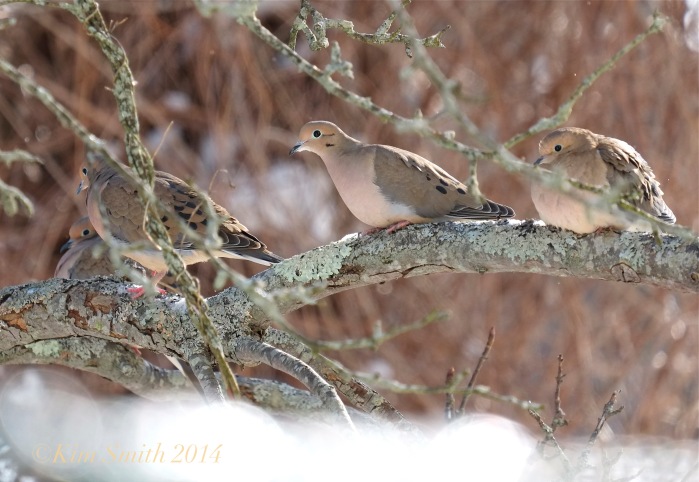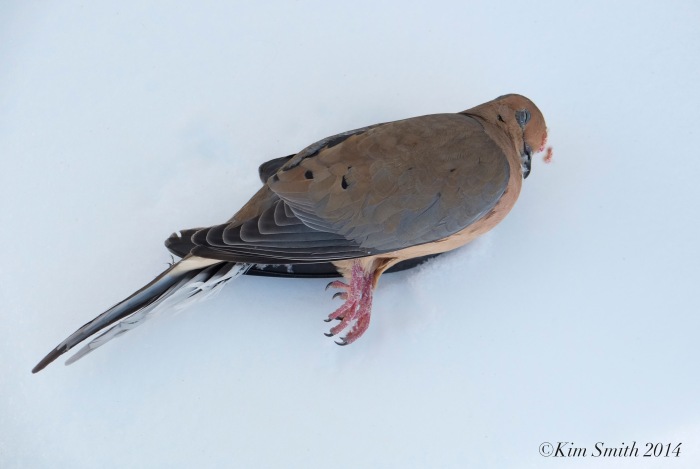 Pair of Mourning Doves in Pear Tree
Pair of Mourning Doves in Pear Tree
While writing this post and listening to recorded songs of Mourning Doves, I was immediately transported to my grandparent’s summer cottage on Cape Cod. Their home was sited on a bluff overlooking Cape Cod Bay. Adjacent to the house was a tumbled and scrubby overgrown field and, only a sort walk down down the lane, the freshwater Hiram Pond. There was no shortage of bunnies and birds, toads and turtles, along with the occasional frog and fox. From a child’s point view, it was pure paradise. Mixed with the sound of the surf, imprinted forever is the familiar song of Mourning Doves cooing at the first light of dawn. For much of the day the nesting doves remained hidden in the tangled undergrowth. Then in the fading rosy light of day’s end, their gentle song was heard again mixed with the laughter of rambunctious family feasts on the screened porch my grandfather had built.
* * *
Mourning Doves during the winter months are not calling to their mates but instead are struggling to survive the cold temperatures and sparse supply of food. Our bird feeders are filled often during the week, primarily with safflower seeds. As I have explained in previous posts, squirrels, which can be a real nuisance at feeders, typically are not interested in safflower seeds. Suet and such invites rats, rabbits, and raccoons, which in turn draws coyotes.
 Mourning Doves in Pear Tree ~ fluffed and unfluffed doves
Mourning Doves in Pear Tree ~ fluffed and unfluffed doves
Feathers are insulating and by fluffing, the bird traps pockets of air to hold in body heat and keep out the cold. During warm weather, birds press their feathers close to their bodies to eliminate the insulating air pockets to allow heat to escape.
When the bird is incubating eggs, the insulating properties of feathers can be a drawback because the feathers keep some of the bird’s body heat from reaching the eggs. The bird either sheds some its breast feathers naturally or pulls them out to expose bare skin. The exposed area is called a brood patch.
Read More Here: Feathers
Addendum today ~ So sadly, my husband found beneath our kitchen window this morning a beautiful Mourning Dove. For the past several months we’ve had half a dozen doves, or what looked like three pairs, nestling in the pear trees and at the feeders. Our dead Mourning Dove seemed perfectly intact, except for a few drops of blood on its head. The single greatest threat to songbirds visiting our backyards are collisions with glass. I never thought of our wind- and weather-worn original-to-the-house 1850s window glass as potentially hazardous. Time to rethink our little backyard sanctuary.
 From Bird Watcher’s Digest, the top ten suggestions for making your windows less deadly for birds: The Top 10 Things You Can Do to Prevent Window Strikes
From Bird Watcher’s Digest, the top ten suggestions for making your windows less deadly for birds: The Top 10 Things You Can Do to Prevent Window Strikes
Mourning Dove Coo ~


move the bird feeder away from your house and they will not fly into the windows and kill them self’s.
LikeLike
The bird feeder is not near the house Brian.
LikeLike
LOL! Move the house away from the birds? Sorry you lost one Kim.
LikeLike
Me too Craig. It had fallen so to the snow so perfectly, I was hoping it was only stunned.
LikeLike
My female zebra finch always plucks a patch when they’re sitting on eggs. I never knew why. I just figured she was wearing a bald spot by sitting. Thanks for the info.
LikeLike
Next time she does that Anne, please send a photo and I will add it to the post. Just googled Zebra Finch-what a charming bird–and so aptly named!!
LikeLike
Reader Sandra writes:
Hi Kim,
I emailed once before with a picture of a coyote in our back yard. You have such beautiful pictures on GMG and seem to have a wide knowledge of wildlife and particularly birds.
We have an artist friend from Minnesota visiting us in the spring. He specializes in water foul and has been awarded the duck stamp prize several times. He asked us what kind of water foul he may be likely to see or to look for when he is here on Cape Ann.
Can you direct me to a site or a list for that? I would appreciate it.
Thanks so much.
Sandra Williams
http://cosmicseanotes.blogspot.com/
LikeLike
Hi Sandra,
Thank you for your kind words re my photos.
I think what would be helpful to your friend when he is googling is that he includes the word Essex in his search. Here are several great sites that I know of and there are more:
http://www.bartonstreet.com/tom/birds/essexdetails.html
http://www.massbird.org/ecoc/Index.htm
http://www.massaudubon.org/our-conservation-work/wildlife-research-conservation/statewide-bird-monitoring/breeding-bird-atlases/bba2/find-a-bird
I hope this is helpful Sandra.
Readers, please add any sites you would like to see included here.
LikeLike
Great. Thank you so much, Kim, for your response and information!
LikeLike
Lovely photos of some beautiful birds.
LikeLike
Thank you Kathleen–I know you love to knit–wouldn’t yarn in that beautiful Mourning Dove gray be gorgeous?!?
LikeLike
You write so eloquently about your wonderful childhood memories on the Cape that I feel like I’m right there! Mine are of a smaller Cape, Gloucester, of course… Good Harbor Beach, and my grandmother’s home on top of Mt. Vernon St. These wonderful memories sustain me, even today.
Hearing a sea gull cry, while shopping in Portsmouth is music to my ears!
It’s no wonder the doves were “fluffing.” It’s been below zero the past two mornings. Enough already!
I love your informative posts and lovely photographs, Kim. You are truly talented. Keep them coming.
LikeLike
Thank you so much Leslie- very kind of you to say.
Too cold–I am trying to “hike” around our neighborhood to get in shape for 5 mile hike in Mexico and my knees freeze before i get very far. Could use some feathers or fur–doubling up on pants!
LikeLike
Just beautiful
LikeLike
Thanks Patti–beautiful, beautiful birds, and hard to capture as they shy away from the softest rustle.
LikeLike
It is always hard losing a bird friend…It may be glass but again ir may be something else never know for sure…I watched a sparro this way on my window sill just looking around trying to get out of elements opened the outerwindow glass and he moved in by the screen think liked the heat went to get some bread crumbs was gone by the time I got back…Thanks 🙂
LikeLike
What month is your trip to Mexico, Kim? I hope it’s soon, so you can get a break from our severe winter. We could all do with a bit of warmth and sunshine.
LikeLike
Leslie I am leaving in a week!!!!
I will be in the mountains in an unheated hotel where the temperature goes down to 30 degrees at night–I’ve been forewarned and will be traveling with winter coat, extra pajamas, and wearing lots of layers as it may go up to 55-60 during the day. It’s going to be the adventure of a lifetime, in more ways than one!
I am hoping/praying it will be sunny–no sun = no butterflies!
LikeLike
Well, that climate is not quite what I envisioned when you said, Mexico.
Can’t wait to hear about your trip!
LikeLike
Hi Leslie–I hope you are seeing last night’s post! Posts get so easily buried with all the good local updates!
LikeLike
I’ll be sure to check it out.
LikeLike
I have a fluffed up dove on my back deck – hasn’t moved in an hour & 20 minutes. It is very cold & windy out & I feel very bad for it. Can I put anything out there to keep it warm?
From Pennsylvania
LikeLike
Thanks for writing Patricia. No, the dove is keeping itself warm by fluffing out its feathers. Is it positioned in a somewhat sheltered spot in your garden?
I find Mourning Doves love safflower seeds and provide plenty of it, especially during this never-ending winter, now spring!
LikeLike